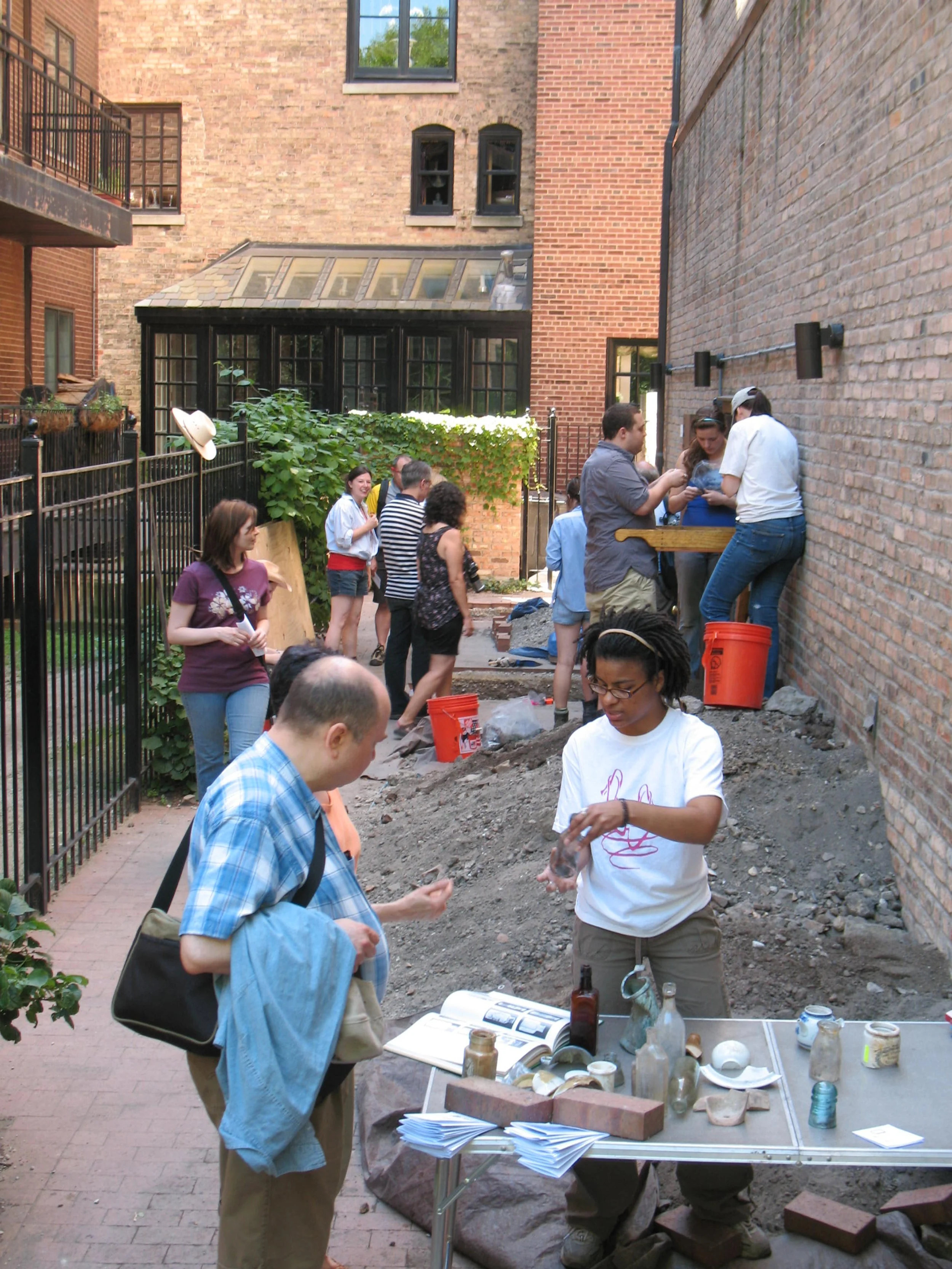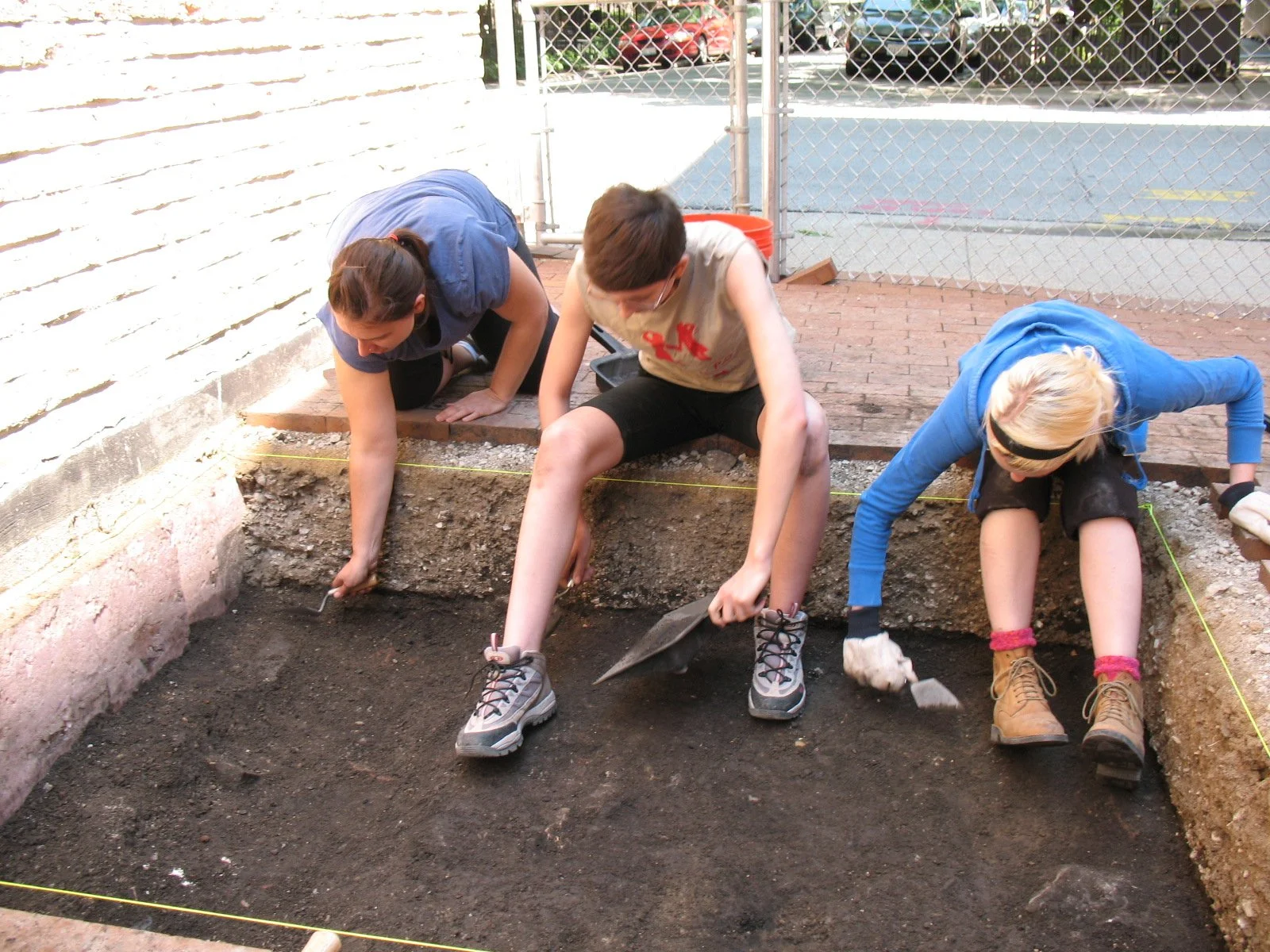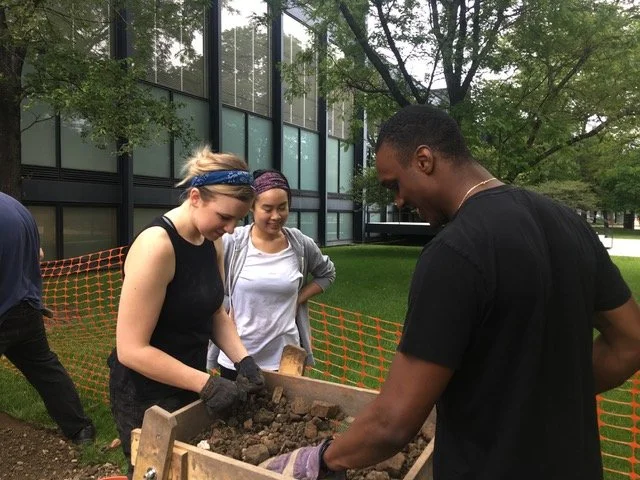
Behind the Scenes at the Digs
A view of the varieties of activity characteristic of an archaeological dig, as exemplified by the Charnley-Persky House Archaeological project—excavation in the far background, screening of soil for artifacts on the right, and public interpretation in the foreground, 2010.
Student excavators systematically removing material to expose artifacts and features during the 2010 season of the Charnley-Persky House Archaeological Project.
Lake Forest College students Anne Marie Brugioni and Dasha Rodina pose with a milk glass cheese container recovered during the 2015 excavations at the Charnley-Persky House.
Elizabeth Mescher (left) instructs IIT volunteers on recovering artifacts from screened dirt. Photograph by Rebecca S. Graff.
Smoking pipe stem, Bennington clay marble, and ceramic fragment recovered from the Mecca Flats excavation, July 2018. Photograph by Rebecca S. Graff.
Original tiles from the Mecca Flats revealed during excavation, July 2018. Photograph by Rebecca S. Graff.
Above: Excavating the construction backfill at the Mecca Flats site, July 2018, Rebecca Graff, Debora Heard, and Paula Pelletier. Photograph by Holly Swyers.
Archaeology in and Of Chicago
Archaeology, a sub-field of anthropology, is the study of people’s pasts through the materials they left behind. It is, in other words, the study of other people’s garbage. That material culture, in the form of artifacts, ecofacts, and features, can be used to provide insight into the lives of “those of little note” whose lives are not visible in the documentary record, having been marginalized by “dominant social, political, and economic” groups and structures of power (Scott 1994:3).
There is a long tradition of archaeology in American cities, and increasing visibility for work done on the recent past (Rothschild and DiZerega Wall 2014). Yet in the context of Chicago-area archaeology, the projects at the Charnley-Persky House and the Mecca Flats were unusual. First, not many digs are undertaken in the city. Second, digs in Chicago tend to privilege the very old—pre-contact Indigenous sites—while mostly avoiding 19th- and 20th-century sites. Materials from the recent past are definitely turned up with regularity in the city through, for example, construction projects. However, the absence of institutional mechanisms to enforce the laws on the books requiring archaeological surveys (Chicago has no city archaeologist, for example), plus the long-standing pattern of privileging business interests, means that opportunities like that provided by SAH and the Charnley-Persky House Museum Foundation are rare and valuable. In fact, the Illinois Archaeological Survey recognized Pauline Saliga with a public service award in 2010 for her all-too unique contribution: inviting archaeological research into a Chicago site.
The Charnley-Persky House Archaeological Project, 2010 and 2015
Renovation work at the Charnley-Persky House between 2001 and 2003 involved digging a trench on two sides of the building to install water-proofing material below grade. An eight-foot-deep trench dug along the eastern wall of the house revealed a rich deposit of refuse from the turn of the 20th century. Initially, SAH staff members documented and preserved materials from the area. In 2008, Pauline Saliga, then executive director of SAH, contacted Rebecca Graff, then an anthropology doctoral student at the University of Chicago, having heard of her work excavating the 1893 World’s Columbian Exposition site in Jackson Park. Saliga wanted to have a professional excavation of the site, to link the scholarship on the built environment to what could be found archaeologically—the social history.
There have been two archaeological excavation seasons at the Charnley-Persky House for a total of nine weeks of excavation. Graff directed the 2010 archaeological field school through DePaul University's Urban Historical Archaeology Field School program with assistance from Mary Leighton. Over 20 undergraduate students worked for five weeks to uncover artifacts and features at the site. In 2015, Graff directed excavations through Lake Forest College, assisted by Tiffany Charles and supported by a grant from the Andrew W. Mellon Digital Humanities Foundation. The field school included 10 students from Lake Forest College, Beloit College, St. Olaf College, Northeastern Illinois University, and Chicago's Lane Tech High School.
Over 28,000 artifacts were recovered from the two seasons of excavation, many of which are featured in the Digital Chicago’s Charnley-Persky House Archaeology Project (Graff 2016), currently hosted by the Chicago History Museum. Much of this material was analyzed and made up the basis of Graff’s book, Disposing of Modernity (2020), which looked at how the promises of the 1893 World’s Columbian Exposition were consumed in the domestic spaces of the Charnley-Persky House.
Media coverage of both excavation seasons was extensive and provides a glimpse into the inner workings of archaeological field research. Examples of that coverage include:
Chicago Tribune: Getting the Dirt on Chicago High Society,” July 28, 2010, by William Mullen, https://www.chicagotribune.com/news/ct-xpm-2010-07-28-ct-x-c-urban-dig-20100728-story.html
Channel 11, PBS News, Chicago Tonight (WTTW): “Students Dig For Lost Treasures in the Gold Coast” http://chicagotonight.wttw.com/2015/07/29/students-dig-lost-treasures-gold-coast
WGNtv News: “Urban dig truly makes trash into treasures for local students” http://wgntv.com/2015/07/28/urban-dig-truly-makes-trash-into-treasures-for-local-students/
CBS News: “Students Digging Up Historical Artifacts At Gold Coast Site” http://chicago.cbslocal.com/2015/07/28/students-digging-up-historical-artifacts-at-gold-coast-site/
Chicago Tribune: “Relics of the past unearthed in Gold Coast” http://www.chicagotribune.com/photos/ct-archaeological-dig-gold-coast-photos-20150728-photogallery.html
Chicago Tribune: “Students dig for architectural treasures in Gold Coast” http://www.chicagotribune.com/news/local/breaking/ct-gold-coast-archeological-dig-met-20150728-story.html
Lake Forest Patch: “Lake Forest College Students Taking Part in Historical Dig” https://patch.com/illinois/lakeforest/lake-forest-college-students-taking-part-historical-dig
Pioneer Press: “Lake Forest College students "dig" Chicago – literally” July 24, 2015, by Mark Lawton
Daily North Shore: “Digging Gold Coast Garbage” July 27, 2015, by Anne Marie Brugioni, Xhris Fitzgerald, and Dasha Rodina, https://jwcdaily.com/2015/07/27/lake-forest-college-students-digging-gold-coast-trash/
The Mecca Flats Archaeological Salvage Project, July 2018
Like at the Charnley-Persky House, it was construction work alongside the western edge of S.R. Crown Hall that led to the “rediscovery” of the Mecca Flats in 2018. In that case, repair work on a steam tunnel revealed the basement floor of the Mecca Flats, formed from brightly-colored encaustic tiles.
Graff was brought onto the project by the generous work of Tim Samuelson, the City of Chicago’s cultural historian, to incorporate archaeological research into the project. With only a few hours to work before local architects removed the extant tile floor in large chunks, and with the construction project needing to restart, a volunteer crew of students, faculty, and staff from Lake Forest College, IIT, and the University of Chicago went in. We tried to recover as many artifacts as possible from the construction backfill by screening soil through 1/4-inch mesh—the standard practice for North American sites. In all, almost 400 artifacts were recovered, with the bulk of the materials (75%) representing architectural materials that once formed the Mecca, such as brick, glazed tile, and privacy glass. After laboratory analysis, the collection was returned to IIT and is now housed in their archives.
The media coverage of the rediscovery of the Mecca Flats included:
Chicago Tribune: Long-demolished World’s Fair building unearthed at IIT, tells story of Chicago's racial divide.” http://www.chicagotribune.com/news/local/breaking/ct-met-iit-construction-unearths-mecca-flats-20180804-story.html
Illinois Institute of Technology: “Mecca Flat Revealed Roundtable.” https://vimeo.com/285866366
“Steam Tunnel Repair Reveals Intact Tiles, Artifacts from Historic Mecca Flats” https://news.iit.edu/stories/2018/08/steam-tunnel-repair-reveals-intact-tiles-artifacts-historic-mecca-flats
Atlas Obscura, Hannah Steinkopf-Frank: “Rediscovering Mecca Flats, a Legendary Chicago Apartment Building” https://www.atlasobscura.com/articles/history-of-mecca-flats-in-chicago
Chicago Humanities Festival: “Small Object, Giant Leap: Mecca Flats.” https://chicagohumanities.org/media/mecca-flats-small-object-giant-leap/
< Previous Page | Next Page >





